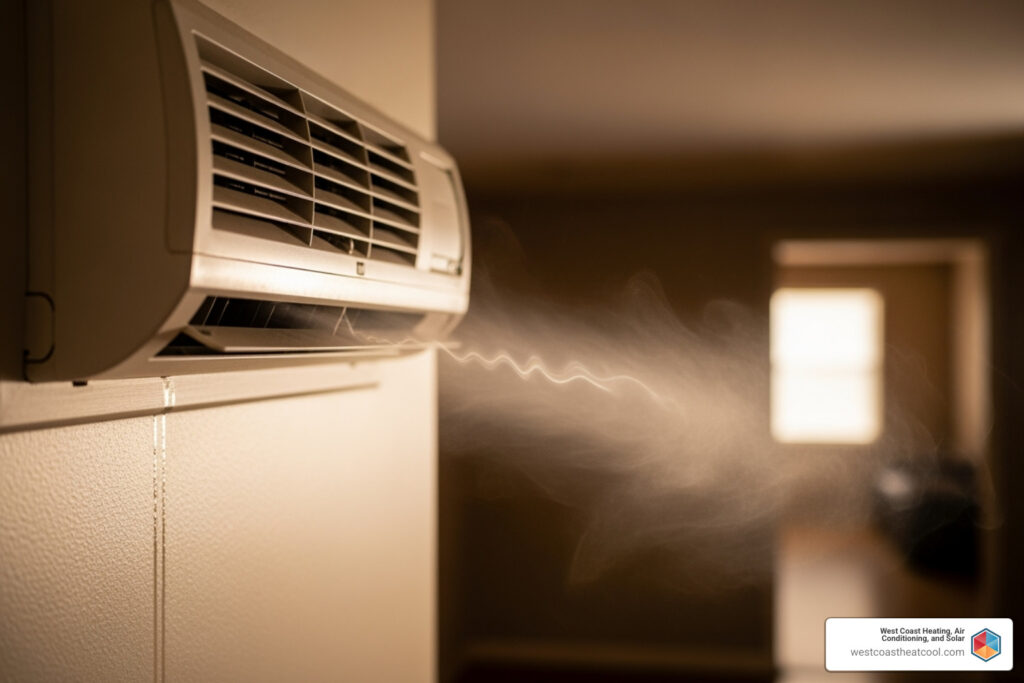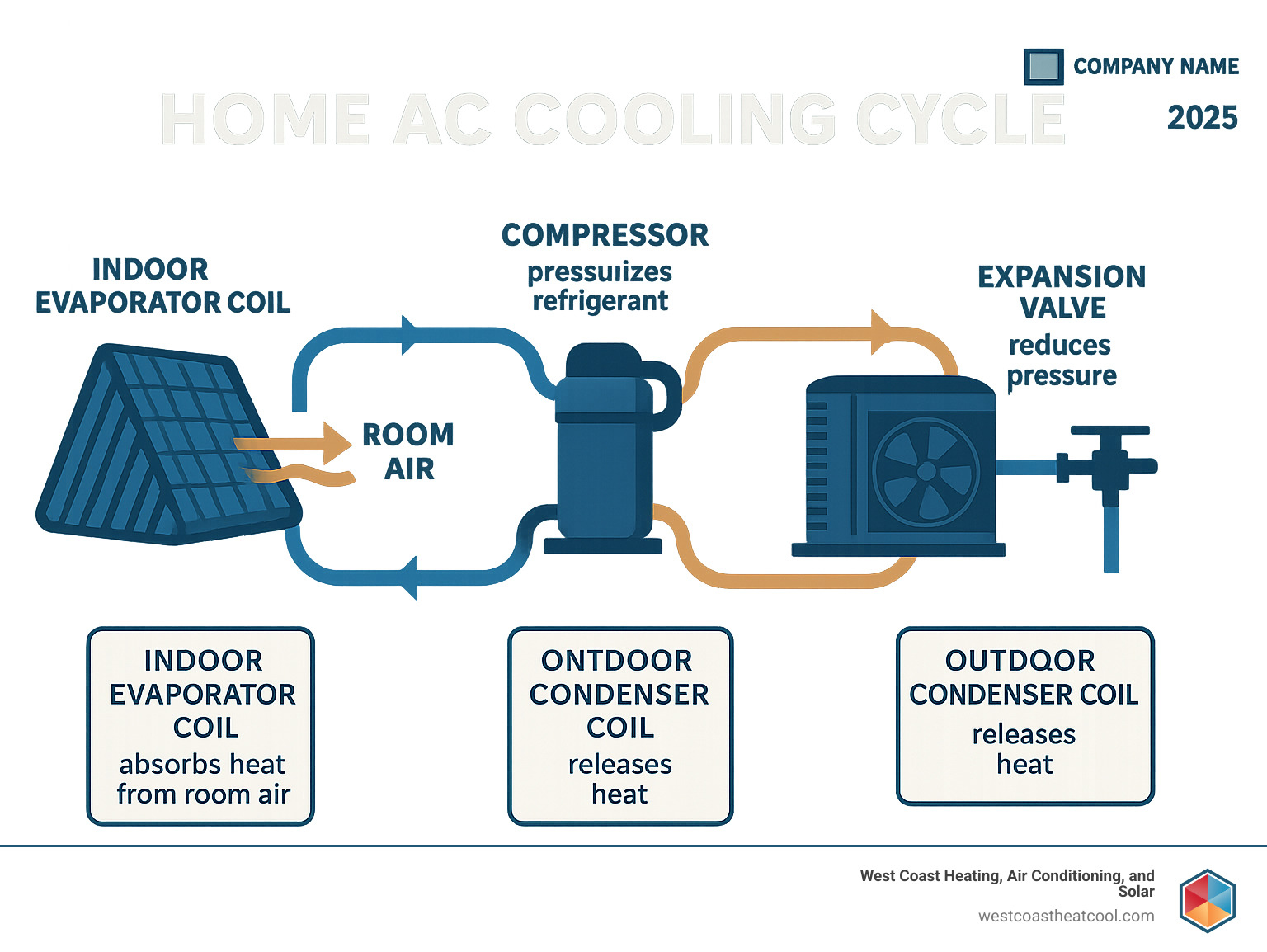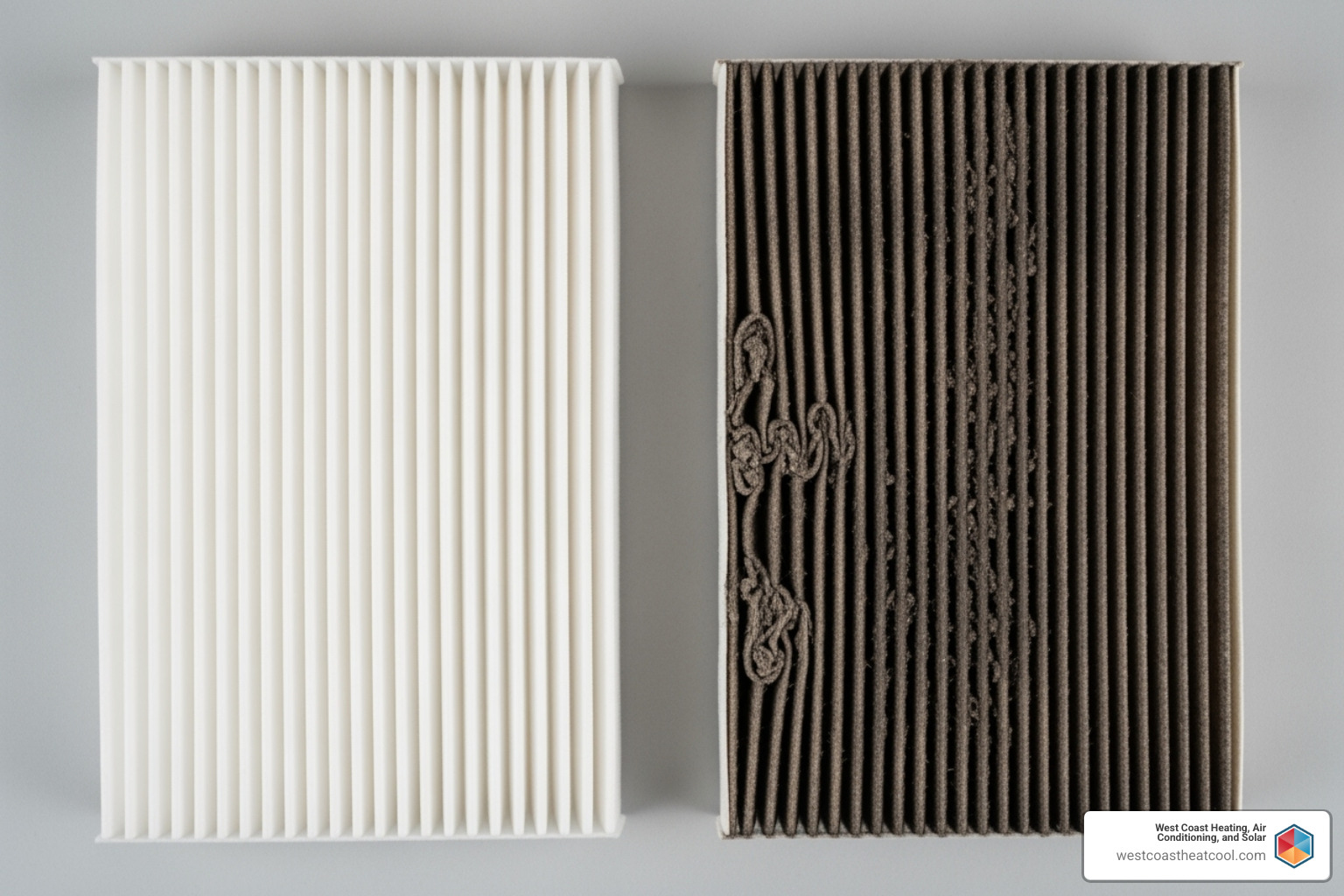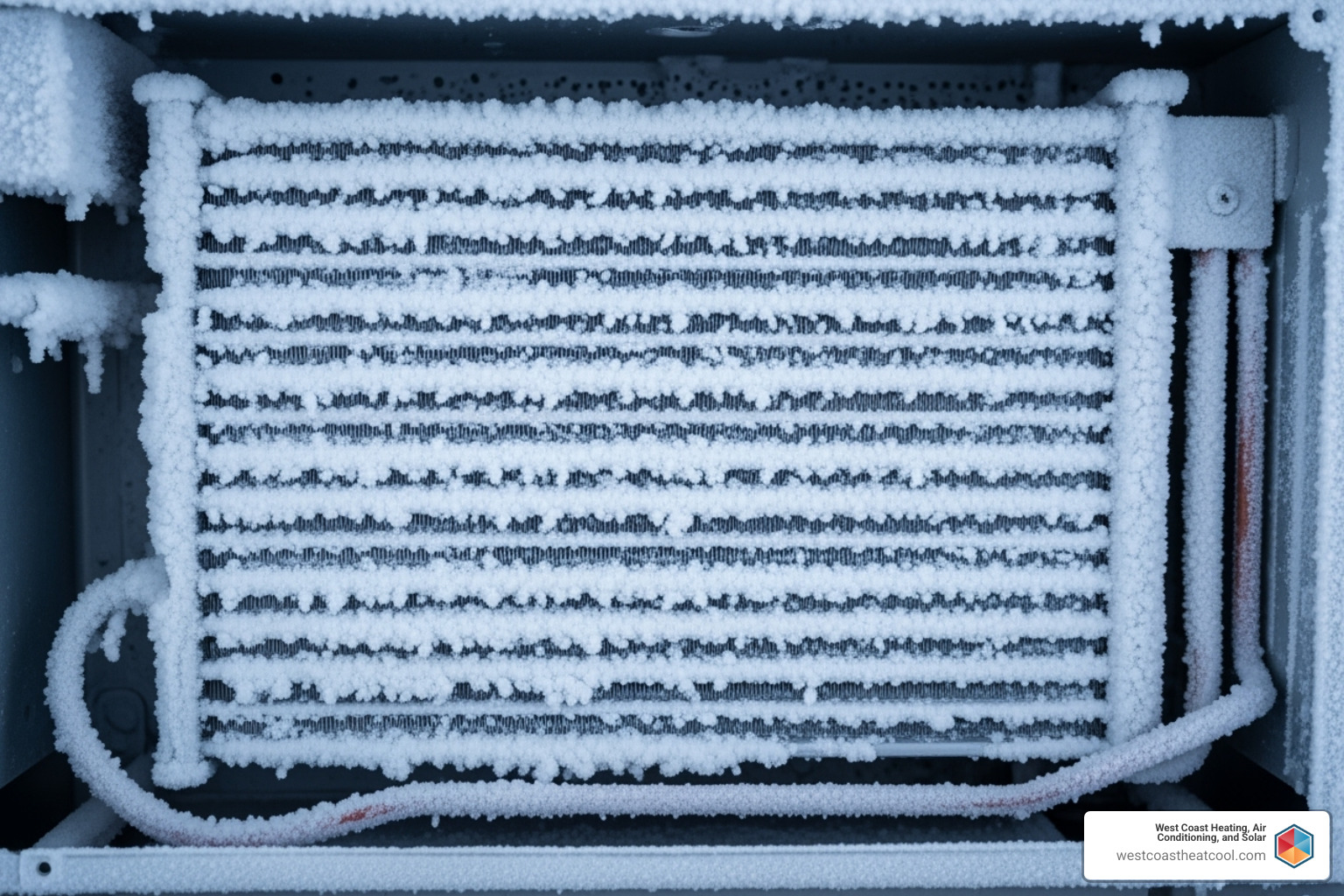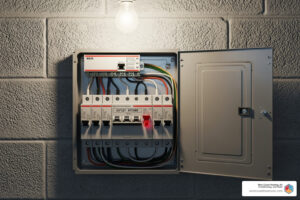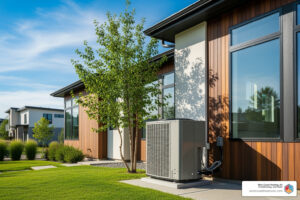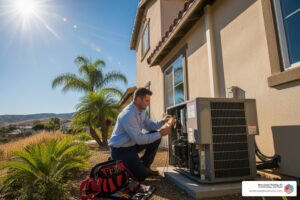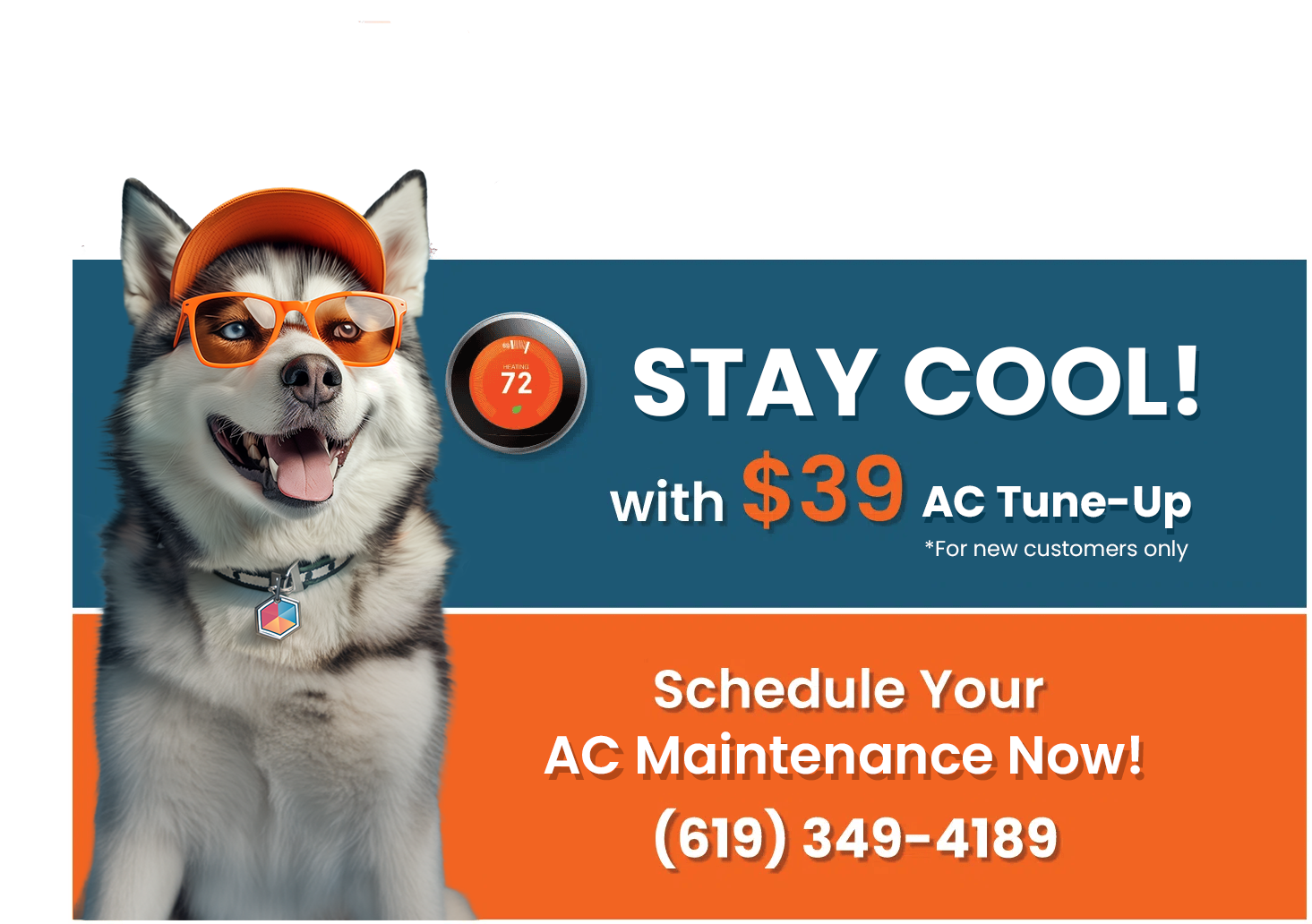Why Is My AC Blowing Hot Air?
When your AC blowing hot air turns your home into an oven, it’s a frustrating problem. Your AC system is designed to remove heat from inside your home and release it outdoors. When this process fails, you get warm air instead of cool comfort. Here are the most common causes and what to do about them:
- Thermostat Issues: Ensure it’s set to COOL (not HEAT) and the fan is on AUTO.
- Dirty Air Filter: Replace if clogged (check every 1-3 months).
- Tripped Circuit Breaker: Reset the breakers for both indoor and outdoor units.
- Low Refrigerant: This indicates a leak and requires professional repair.
- Frozen Coils: Turn off the AC to let it thaw and check for airflow blockages.
- Compressor Problems: Listen for unusual noises and call a professional.
Some of these issues are simple DIY fixes, while others, like refrigerant leaks or compressor failure, need an expert. The key is knowing which problems you can tackle yourself and when to call for help.
This guide covers troubleshooting for both home and car AC systems, helping San Diego residents beat the heat wherever they are.
First-Step Diagnostics: Simple Checks for Your Home AC
Before panicking, perform these simple checks. Often, an AC blowing hot air is due to a minor issue you can fix yourself.
Check Your Thermostat Settings
This simple step is often the solution. Ensure your thermostat is set to “COOL” mode, not “HEAT” or “FAN ONLY.” The fan setting should be on “AUTO,” not “ON,” to prevent the blower from circulating unconditioned air when the system isn’t actively cooling.
Next, confirm the temperature is set lower than the current room temperature, or the AC won’t turn on. For optimal comfort in San Diego, we recommend a setting between 72 and 78 degrees Fahrenheit.
Finally, check the batteries if your thermostat uses them, as dead batteries can cause erratic behavior. For smart thermostats, ensure it’s connected to Wi-Fi.
Inspect and Clean Your Air Filters
A dirty air filter is a primary cause of an AC blowing hot air. A clogged filter restricts airflow, forcing your AC to work harder and reducing its cooling power. This can also lead to other problems, like frozen evaporator coils.
Most filters need replacing every 1-3 months, especially if you have pets. To change your filter:
- Turn off your AC system at the thermostat.
- Locate the air filter in the return air duct or air handler.
- Remove the old filter, noting the airflow direction arrow.
- Inspect the filter. If it’s visibly dirty or you can’t see light through it, replace it.
- Insert a new, clean filter of the correct size, matching the airflow arrow’s direction.
- Turn your AC system back on.
This simple task is a critical part of routine maintenance and can significantly improve performance.
Reset the Circuit Breaker
If your outdoor unit isn’t running, a tripped circuit breaker could be the cause. Your AC system has two breakers: one for the indoor unit and one for the outdoor unit. If the outdoor unit’s breaker trips, the indoor fan may still run, circulating warm air.
To reset the breaker:
- Locate your electrical panel (often in a garage or utility closet).
- Find the breakers labeled “AC,” “Furnace,” or “HVAC.”
- If a breaker is tripped (in the “OFF” or middle position), push it firmly to “OFF” first.
- Push the breaker back to the “ON” position.
- Wait 30 seconds before turning the AC back on at the thermostat.
If the breaker trips again, it indicates a serious electrical problem. Do not keep resetting it; call a professional immediately.
- Clean the Condenser Unit: Ensure your outdoor unit is clear of leaves, dirt, and debris. Maintain a 3-foot clear radius around it and gently rinse the coils with a garden hose.
- Check Return Vents: Make sure all return air vents inside your home are unblocked by furniture or curtains to ensure proper airflow.
Why Your Home AC is Blowing Hot: Deeper System Issues
If the simple checks don’t solve your AC blowing hot air problem, the issue is likely deeper within the system. These problems involve critical components and require professional diagnosis and repair. Refrigerant, the lifeblood of your AC, absorbs heat from your home. When something goes wrong with it or the components that handle it, the system fails to cool.
At West Coast Heating, Air Conditioning, and Solar, we know that a well-maintained AC unit can avoid most of these problems. Regular maintenance catches small issues before they become expensive headaches.
Low Refrigerant Levels and Leaks
Your AC doesn’t “use up” refrigerant; it operates in a closed system. If levels are low, you have a leak. Simply adding more refrigerant without fixing the leak is a temporary solution at best. Low refrigerant is a common reason for an AC blowing hot air because there isn’t enough fluid to absorb heat from your home’s air.
Signs of a leak include:
- Hissing or bubbling sounds from the AC unit.
- Oily residue around refrigerant lines.
- Ice forming on the evaporator coils or refrigerant lines.
Handling refrigerant requires specialized equipment and is regulated by the EPA. A professional technician can accurately locate and repair leaks, then recharge your system to the correct specifications.
Frozen Evaporator Coils
Finding your indoor AC unit covered in ice means the evaporator coils have frozen over. This icy blanket prevents the coils from absorbing heat, resulting in your AC blowing hot or lukewarm air.
Common causes include dirty air filters restricting airflow, low refrigerant levels, or clogged drain lines that cause moisture buildup. If you find frozen coils, turn off your AC immediately. Set the fan to “ON” to help circulate air and speed up the thawing process, which can take several hours.
Once thawed, check the air filter. If it’s clean, the problem is likely low refrigerant or another mechanical issue that needs a professional. Running an AC with frozen coils can destroy the compressor.
A Malfunctioning Compressor or Condenser Fan
The compressor is your AC’s heart, pumping refrigerant through the system. When it fails, your AC blowing hot air is a primary symptom. Red flags for a failing compressor include:
- Grinding, rattling, or squealing noises from the outdoor unit.
- The circuit breaker repeatedly tripping.
- A significant reduction or complete loss of cooling.
The condenser fan works with the compressor to release heat outdoors. If the fan blades aren’t spinning, heat gets trapped in the system. This could be due to debris, but it often means the fan motor has failed and needs professional replacement. Both compressor and fan issues involve high voltage and pressurized refrigerant, making them jobs for an expert.
Electrical Problems and Duct Leaks
Other issues can also cause cooling problems. Faulty capacitors or contactors can prevent the compressor and fan motors from starting. Damaged wiring from age or pests can interrupt power and create a safety hazard.
Duct leaks in your attic or crawlspace allow cool air to escape and hot air to enter the system. This leads to uneven cooling and reduced efficiency, making it feel like your AC blowing hot air in some rooms. Professional duct inspection and sealing are necessary to fix these hidden energy-wasting gaps.
On the Road Again? Troubleshooting Your Car’s AC
When your car’s AC blowing hot air, it can make any San Diego commute unbearable. A car’s AC works on the same principles as a home unit but is more compact and subject to harsher conditions like vibration and road debris.
Common Causes for a Car AC Blowing Hot
- Low Refrigerant: This is the most common issue. Unlike home systems, car ACs are prone to small leaks from deteriorating rubber hoses and seals.
- Faulty Compressor: The compressor clutch may not engage, or you might hear grinding noises from under the hood.
- Blocked Condenser: Located at the front of the vehicle, the condenser can get clogged with road debris, preventing it from releasing heat.
- Electrical Issues: A blown fuse, faulty relay, or damaged wiring can disable the entire AC system.
- Failing Expansion Valve: This can cause the AC to alternate between blowing cold and hot air.
How to Recharge a Car’s AC System
While professional service is recommended, some owners try recharging the system. This is only a temporary fix if there’s a leak.
Warning: Use safety glasses and gloves. Refrigerant can be harmful.
- Get the right kit: Purchase an AC recharge kit with the correct refrigerant (e.g., R-134a) for your vehicle.
- Locate the low-pressure port: It’s usually on the larger AC line with a cap marked “L.”
- Connect the hose: Attach the recharge kit’s hose to the port.
- Start the engine and AC: Turn the engine on and set the AC to max cold and high fan.
- Add refrigerant: Attach the can and slowly add refrigerant, keeping the can upright. Monitor the pressure gauge on the kit and fill to the recommended range shown in the instructions.
- Do not overcharge: Too much refrigerant can damage the system.
- Disconnect and test: Once at the proper pressure, disconnect the kit and check if the air is cold.
Important: If the system needs a full can or the problem returns quickly, you have a significant leak. Do not keep adding refrigerant; see a qualified mechanic.
The Best Defense: Preventative Maintenance and Knowing When to Call for Help
Proactive care is the best way to prevent your AC blowing hot air. Just like a car needs oil changes, your AC needs regular maintenance to run efficiently and last its full 15- to 20-year lifespan. In San Diego’s climate, these tune-ups are essential for comfort and keeping energy bills down.
At West Coast Heating, Air Conditioning, and Solar, we’ve seen since 1996 how preventative care saves homeowners from expensive emergency repairs.
Preventative Maintenance Checklist
Keep your system healthy with these key tasks:
- Regular filter changes: This is the most important step. Replace filters every 1-3 months, or monthly during peak season.
- Clean coils: Gently rinse your outdoor condenser coils with a garden hose. Professional cleaning is best for delicate indoor evaporator coils.
- Clear drain lines: Prevent water backup and frozen coils by pouring a cup of distilled vinegar and water down the drain line a few times a year.
- Keep outdoor unit clear: Maintain at least two feet of clearance around your condenser, free of leaves, bushes, and debris.
- Seal air leaks: Check for leaks around windows, doors, and in ductwork to help your AC work smarter, not harder.
When to Call a Professional
While DIY checks are useful, some problems require an expert. Knowing when to call for help can save you time, money, and prevent further damage.
Call a professional if:
- Basic troubleshooting fails: You’ve checked the thermostat, filter, and breaker, but the AC blowing hot air persists.
- You suspect a refrigerant leak: Handling refrigerant is not a DIY job.
- You have electrical problems: A constantly tripping breaker or suspected wiring issues are serious safety risks.
- You hear loud or unusual noises: Grinding, squealing, or rattling sounds indicate mechanical failure.
- Your AC won’t turn on at all, despite having power.
- Your coils repeatedly freeze over, even with a clean filter.
Our team has the experience and tools to diagnose these problems accurately and restore your comfort.
Frequently Asked Questions About an AC Blowing Hot Air
When your AC blowing hot air on a sweltering day, you have questions. Here are answers to the most common concerns we’ve heard from San Diego homeowners since 1996.
How much does it cost to fix an AC blowing hot air?
The cost to fix an AC blowing hot air can range from $150 to $600 or more, depending on the problem. A simple fix like a new capacitor might be on the lower end ($150-$300), while a refrigerant leak repair could be more ($200-$500). A major issue like a failed compressor can be significantly more expensive.
The best approach is to get a professional estimate. A qualified technician can diagnose the issue and provide transparent, upfront pricing so you can make an informed decision.
Should I turn my AC off if it’s blowing hot air?
Yes, turn it off immediately. Continuing to run the system when it’s not cooling can cause severe damage to expensive components, especially the compressor. It’s like driving a car with an overheating engine.
Turning the AC off prevents further damage, saves energy, and protects your compressor from burnout. After turning it off, you can safely perform the basic checks (thermostat, filter, breaker). If those don’t work, keep the system off until a professional arrives.
What are the signs of a failing AC compressor in a home system?
Your AC compressor is the heart of your system. Recognizing the warning signs of failure can help you avoid a complete breakdown. Look out for:
- Unusual Noises: Grinding, squealing, or rattling sounds from the outdoor unit are a major red flag.
- Tripping Circuit Breaker: If the breaker for your outdoor unit trips repeatedly, the compressor may be drawing too much power.
- Reduced Cooling: The system runs, but the air is warm or barely cool because the compressor can’t circulate refrigerant effectively.
- Fluid Leaks: Oily stains near the outdoor unit can indicate a refrigerant leak from the compressor.
If you notice these signs, call a professional right away. Catching compressor problems early can sometimes be the difference between a repair and a full replacement.
Conclusion: Restoring Cool Comfort to Your San Diego Home
When your AC blowing hot air disrupts your comfort, it’s frustrating, but you’re now equipped to handle many common causes. Always start with the simple checks: thermostat settings, air filters, and circuit breakers. These steps often provide a quick fix.
For more complex issues like refrigerant leaks, frozen coils, or a failing compressor, it’s best to call in the experts. Attempting to fix these yourself can lead to more significant and costly repairs.
The best way to prevent future breakdowns is with regular maintenance. Consistently changing filters, cleaning your outdoor unit, and scheduling annual tune-ups will extend your system’s life and improve its efficiency.
At West Coast Heating, Air Conditioning, and Solar, we’ve provided reliable service to San Diego County families since 1996. From Chula Vista to Carlsbad, our team understands our local climate and is dedicated to keeping your home comfortable.
A functional AC is essential in San Diego. Your home should be a cool refuge from the heat. If your troubleshooting hasn’t worked or you notice serious warning signs like strange noises, our experienced technicians are ready to help. We’ll diagnose the problem quickly and get your system back to blowing cool air.
Don’t suffer through the heat. Professional help is just a call away.

